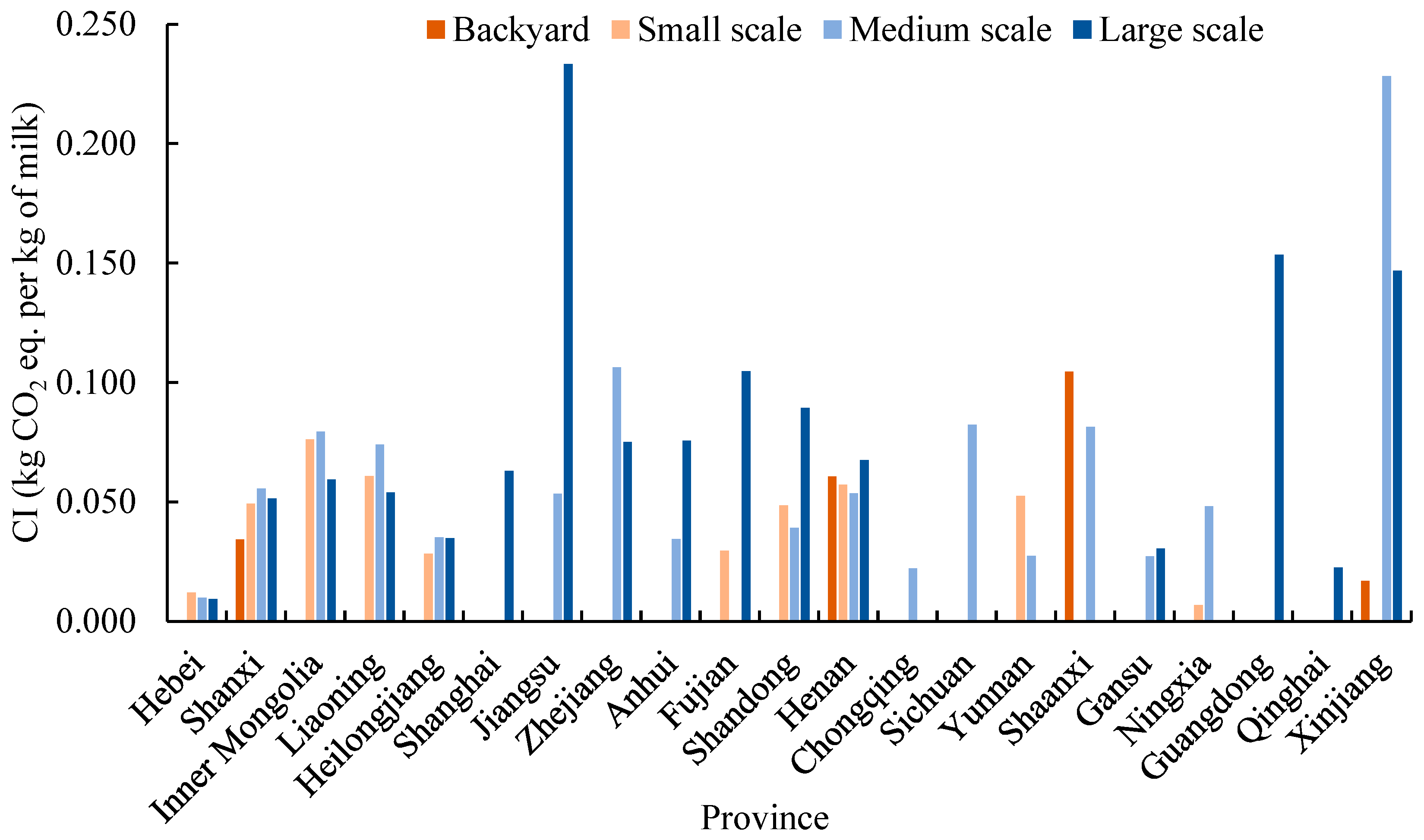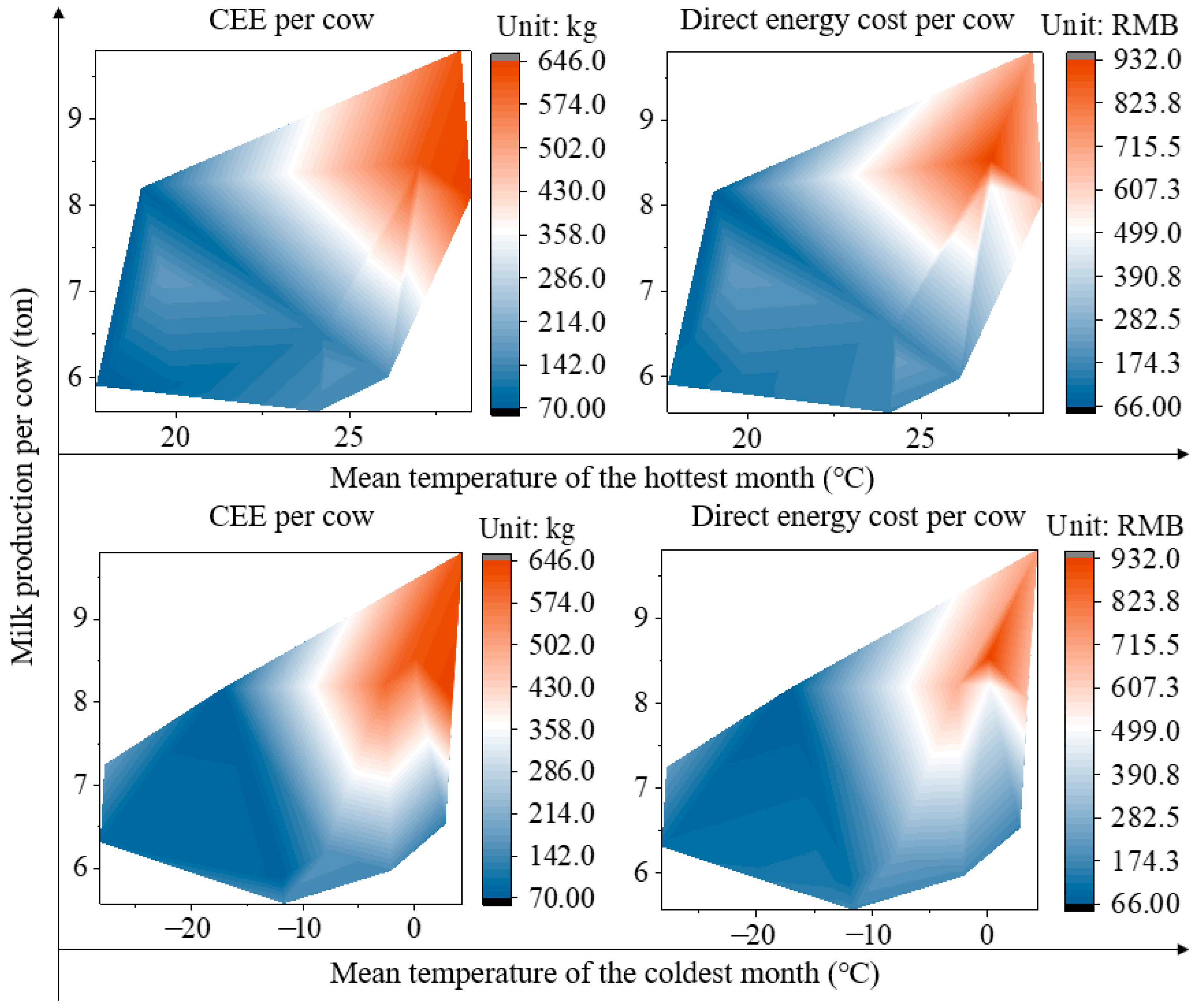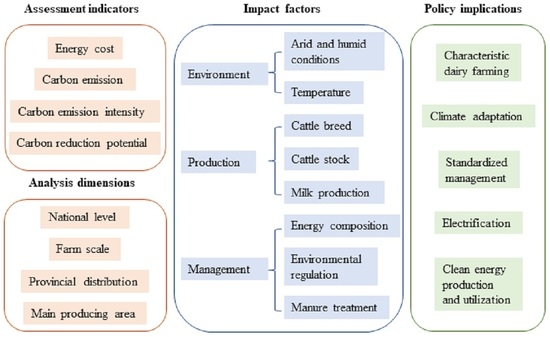Sustainable Planning Strategy of Dairy Farming in China Based on Carbon Emission from Direct Energy Consumption
Abstract
1. Introduction
2. Materials and Methods
2.1. Data Acquisition
2.2. The Calculations of CE and CI
2.3. Main Milk-Producing Area and CRP Analysis
2.4. Data Process and Analysis
3. Results
3.1. Overview of CE from Dairy Farming
3.2. CIs of Dairy Farms with Different Herd Sizes
3.3. The Inter-Provincial Distribution of CI and CE
3.4. CRP in the Main Milk-Producing Area
3.5. Impact Factors in the Main Milk-Producing Area
4. Discussion
4.1. Nationwide Overview of Dairy Farming
4.2. Dairy Farming in Main-Milk Producing Area
5. Conclusions
Author Contributions
Funding
Institutional Review Board Statement
Data Availability Statement
Conflicts of Interest
References
- Chen, B.; Zhang, H.Y.; Li, W.; Du, H.Y.; Huang, H.; Wu, Y.; Liu, S.M. Research on provincial carbon quota allocation under the background of carbon neutralization. Energy Rep. 2022, 8, 903–915. [Google Scholar] [CrossRef]
- Yuan, R.; Ma, Q.; Zhang, Q.; Yuan, X.; Wang, Q.; Luo, C. Coordinated effects of energy transition on air pollution mitigation and CO2 emission control in China. Sci. Total Environ. 2022, 841, 156482. [Google Scholar] [CrossRef]
- FAOSTAT (FAO Statistical Databases). Available online: http://www.fao.org/faostat/en/#home (accessed on 25 October 2020).
- Bassignana, C.F.; Merante, P.; Belliére, S.R.; Vazzana, C.; Migliorini, P. Assessment of Agricultural Biodiversity in Organic Livestock Farms in Italy. Agronomy 2022, 12, 607. [Google Scholar] [CrossRef]
- Zhuang, M.; Shan, N.; Wang, Y.; Caro, D.; Fleming, R.M.; Wang, L. Different characteristics of greenhouse gases and ammonia emissions from conventional stored dairy cattle and swine manure in China. Sci. Total Environ. 2020, 722, 137693. [Google Scholar] [CrossRef] [PubMed]
- NBSC (National Bureau of Statistics of China). China Rural Statistical Yearbook 2020; China Statistics Press: Beijing, China, 2020.
- DAC (Dairy Association of China). China Dairy Yearbook; China Agricultural Press: Beijing, China, 2020. [Google Scholar]
- Martinsson, E.; Hansson, H. Adjusting eco-efficiency to greenhouse gas emissions targets at farm level? The case of Swedish dairy farms. J. Environ. Manag. 2021, 287, 112313. [Google Scholar] [CrossRef] [PubMed]
- MOA (Ministry of Agriculture and Rural Affairs of the People’s Republic of China). Available online: http://www.moa.gov.cn/nybgb/2023/202302/ (accessed on 23 November 2021).
- IDF (International Dairy Federation). A common carbon footprint approach for the dairy sector: The IDF guide to standard life cycle assessment methodology. In Bulletin of the International Dairy Federation; International Dairy Federation: Brussels, Belgium, 2015; Volume 479, p. 20. [Google Scholar]
- Safa, M.; Samarasinghe, S. CO2 emissions from farm inputs “Case study of wheat production in Canterbury, New Zealand”. Environ. Pollut. 2012, 171, 126–132. [Google Scholar] [CrossRef] [PubMed]
- Houston, C.; Gyamfi, S.; Whale, J. Evaluation of energy efficiency and renewable energy generation opportunities for small-scale dairy farms: A case study in Prince Edward Island, Canada. Renew. Energy 2014, 67, 20–29. [Google Scholar] [CrossRef]
- Shine, P.; Upton, J.; Sefeedpari, P.; Murphy, M.D. Energy Consumption on Dairy Farms: A Review of Monitoring, Prediction Modelling, and Analyses. Energies 2020, 13, 1288. [Google Scholar] [CrossRef]
- Pagani, M.; Vittuari, M.; Johnson, T.G.; De Menna, F. An assessment of the energy footprint of dairy farms in Missouri and Emilia-Romagna. Agric. Syst. 2016, 145, 116–126. [Google Scholar] [CrossRef]
- Moerkerken, A.; Duijndam, S.; Blasch, J.; van Beukering, P.; Smit, A. Determinants of energy efficiency in the Dutch dairy sector: Dilemmas for sustainability. J. Clean Prod. 2021, 293, 126095. [Google Scholar] [CrossRef]
- Jayasundara, S.; Worden, D.; Weersink, A.; Wright, T.; VanderZaag, A.; Gordon, R.; Wagner-Riddle, C. Improving farm profitability also reduces the carbon footprint of milk production in intensive dairy production systems. J. Clean Prod. 2019, 229, 1018–1028. [Google Scholar] [CrossRef]
- Ilyas, H.M.A.; Safa, M.; Bailey, A.; Rauf, S.; Pangborn, M. The Carbon Footprint of Energy Consumption in Pastoral and Barn Dairy Farming Systems: A Case Study from Canterbury, New Zealand. Sustainability 2019, 11, 4809. [Google Scholar] [CrossRef]
- Zira, S.; Röös, E.; Rydhmer, L.; Hoffmann, R. Sustainability assessment of economic, environmental and social impacts, feed-food competition and economic robustness of dairy and beef farming systems in South Western Europe. Sustain. Prod. Consump. 2023, 36, 439–448. [Google Scholar] [CrossRef]
- Huang, X.; Shi, B.; Wang, S.; Yin, C.; Fang, L. Mitigating environmental impacts of milk production via integrated maize silage planting and dairy cow breeding system: A case study in China. J. Clean Prod. 2021, 309, 127343. [Google Scholar] [CrossRef]
- Wang, X.Q.; Kristensen, T.; Mogensen, L.; Knudsen, M.T.; Wang, X.D. Greenhouse gas emissions and land use from confinement dairy farms in the Guanzhong plain of China—using a life cycle assessment approach. J. Clean Prod. 2016, 113, 577–586. [Google Scholar] [CrossRef]
- Hou, J.; Styles, D.; Zhang, W. Improving nutrient and economic efficiency of dairy intensification depends on intensive use of scattered cropland. Sustain. Prod. Consump. 2022, 30, 454–466. [Google Scholar] [CrossRef]
- Kiesse, T.S.; Corson, M.S.; Wilfart, A. Analysis of milk production and greenhouse gas emissions as a function of extreme variations in forage production among French dairy farms. J. Environ. Manage. 2022, 307, 114537. [Google Scholar] [CrossRef] [PubMed]
- Rotz, A.; Stout, R.; Leytem, A.; Feyereisen, G.; Waldrip, H.; Thoma, G.; Holly, M.; Bjorneberg, D.; Baker, J.; Vadas, P.; et al. Environmental assessment of United States dairy farms. J. Clean Prod. 2021, 315, 128153. [Google Scholar] [CrossRef]
- Ranasinghe, R.D.A.K.; Korale-Gedara, P.M.; Weerasooriya, S.A. Climate change adaptation and adaptive capacities of dairy farmers: Evidence from village tank cascade systems in Sri Lanka. Agric. Syst. 2023, 206, 103609. [Google Scholar] [CrossRef]
- Henriksson, M.; Flysjö, A.; Cederberg, C.; Swensson, C. Variation in carbon footprint of milk due to management differences between Swedish dairy farms. Animal 2011, 5, 1474–1484. [Google Scholar] [CrossRef]
- Egas, D.; Ponsá, S.; Llenas, L.; Colón, J. Towards energy-efficient small dairy production systems: An environmental and economic assessment. Sustain. Prod. Consump. 2021, 28, 39–51. [Google Scholar] [CrossRef]
- Jiang, M.J.; Hu, X.J.; Chunga, J.; Lin, Z.Y.; Fei, R.L. Does the popularization of agricultural mechanization improve energy-environment performance in China’s agricultural sector? J. Clean Prod. 2020, 276, 124210. [Google Scholar] [CrossRef]
- Wilkes, A.; Wassie, S.; Odhong, C.; Fraval, S.; van Dijk, S. Variation in the carbon footprint of milk production on smallholder dairy farms in central Kenya. J. Clean Prod. 2020, 265, 121780. [Google Scholar] [CrossRef]
- Meneses, F.; Montenegro, N.; Schapheer, C.; Perez-Quezada, J.F. Historical Changes in Agricultural Systems and the Current Greenhouse Gas Emissions in Southern Chile. Agronomy 2023, 13, 240. [Google Scholar] [CrossRef]
- Tran, D.X.; Pearson, D.; Palmer, A.; Dominati, E.J.; Gray, D.; Lowry, J. Integrating ecosystem services with geodesign to create multifunctional agricultural landscapes: A case study of a New Zealand hill country farm. Ecol. Indic. 2023, 146, 109762. [Google Scholar] [CrossRef]
- NMIC (National Meteorological Information Center). Available online: https://data.cma.cn/data/weatherBk.html (accessed on 16 March 2022).
- GOV (the Government of China). Available online: http://www.gov.cn/guoqing/2005-09/13/content_2582628.htm (accessed on 19 April 2022).
- Uzal, S. Comparison of the Energy Efficiency of Dairy Production Farms Using Different Housing Systems. Environ. Prog. Sustain. Energy 2013, 32, 1202–1208. [Google Scholar] [CrossRef]
- SGCC (State Grid Corporation of China). Available online: http://www.sgcc.com.cn/ (accessed on 18 March 2022).
- NDRC (National Development and Reform Commission). Available online: https://www.ndrc.gov.cn/fggz/zcssfz/hysj/ (accessed on 2 April 2022).
- Zhao, Y.; Cao, Y.; Shi, X.; Li, H.; Shi, Q.; Zhang, Z. How China’s electricity generation sector can achieve its carbon intensity reduction targets? Sci. Total Environ. 2020, 706, 135689. [Google Scholar] [CrossRef]
- Liu, J.P.; Wei, D.L.; Wu, L.; Yang, H.; Song, X.H. Synergy and heterogeneity of driving factors of carbon emissions in China’s energy-intensive industries. Ecol. Indic. 2022, 142, 109161. [Google Scholar] [CrossRef]
- MEE (Ministry of Ecology and Environment of the Peoples’s Republic of China). Available online: https://www.mee.gov.cn/ (accessed on 3 December 2021).
- IPCC (The Intergovernmental Panel on Climate Change). Available online: https://www.ipcc-nggip.iges.or.jp/ (accessed on 25 October 2021).
- Myhre, G.; Shindell, D.; Bréon, F.M.; Collins, W.; Fuglestvedt, J.; Huang, J.; Koch, D.; Lamarque, J.F.; Lee, D.; Mendoza, B.; et al. Anthropogenic and Natural Radiative Forcing. In Climate Change 2013: The Physical Science Basis; Cambridge University Press: Cambridge, UK; New York, NY, USA, 2013. [Google Scholar]
- Li, P.; Zhang, A.; Huang, S.; Han, J.; Jin, X.; Shen, X.; Hussain, Q.; Wang, X.; Zhou, J.; Chen, Z. Optimizing Management Practices under Straw Regimes for Global Sustainable Agricultural Production. Agronomy 2023, 13, 710. [Google Scholar] [CrossRef]
- Shah, W.U.; Hao, G.; Yan, H.; Yasmeen, R.; Jie, Y. The role of energy policy transition, regional energy efficiency, and technological advancement in the improvement of China’s environmental quality. Energy Rep. 2022, 8, 9846–9857. [Google Scholar] [CrossRef]
- Reidsma, P.; Ewert, F.; Lansink, A.O.; Leemans, R. Adaptation to climate change and climate variability in European agriculture: The importance of farm level responses. Eur. J. Agron. 2010, 32, 91–102. [Google Scholar] [CrossRef]
- Dew, J.J.W.; Jack, M.W.; Stephenson, J.; Walton, S. Reducing electricity demand peaks on large-scale dairy farms. Sustain. Prod. Consump. 2021, 25, 248–258. [Google Scholar] [CrossRef]
- Giltrap, D.L.; Kirschbaum, M.U.F.; Laubach, J.; Hunt, J.E. The effects of irrigation on carbon balance in an irrigated grazed pasture system in New Zealand. Agric. Syst. 2020, 182, 102851. [Google Scholar] [CrossRef]
- Barneze, A.S.; Abdalla, M.; Whitaker, J.; McNamara, N.P.; Ostle, N.J. Predicted Soil Greenhouse Gas Emissions from Climate × Management Interactions in Temperate Grassland. Agronomy 2022, 12, 3055. [Google Scholar] [CrossRef]
- Zhang, Z.; Hua, T.; Zhao, Y.; Li, Y.; Wang, Y.; Wang, F.; Sun, J.; Sun, J. Divergent effects of moderate grazing duration on carbon sequestration between temperate and alpine grasslands in China. Sci. Total Environ. 2023, 858, 159621. [Google Scholar] [CrossRef]
- Chen, R.; Kong, Y. Redefine carbon footprint performance with the total factor productivity: A case from a regional food production system. Ecol. Indic. 2022, 144, 109540. [Google Scholar] [CrossRef]
- Liu, X.J.; Jin, X.B.; Luo, X.L.; Zhou, Y.K. Multi-scale variations and impact factors of carbon emission intensity in China. Sci. Total Environ. 2023, 857, 159403. [Google Scholar] [CrossRef]
- Zhao, W.Y.; Choi, C.Y.; Ru, L.; Shi, Z.X.; Li, H. Effect of Rearing Systems on Growth Performance, Lying/Standing Behavior, Morbidity, and Immunity Parameters of Pre-Weaned Dairy Calves in a Continental Zone in Winter. Agriculture 2022, 12, 1496. [Google Scholar] [CrossRef]
- Yan, G.; Liu, K.X.; Hao, Z.; Li, H.; Shi, Z.X. Development and evaluation of thermal models for predicting skin temperature of dairy cattle. Comput. Electron. Agric. 2021, 188, 106363. [Google Scholar] [CrossRef]
- Zhao, W.Y.; Choi, C.Y.; Li, G.M.; Li, H.; Shi, Z.X. Pre-weaned dairy calf management practices, morbidity and mortality of bovine respiratory disease and diarrhea in China. Livest. Sci. 2021, 251, 104608. [Google Scholar] [CrossRef]
- Hou, N.; Zhu, Q.Y.; Zhao, W.Z.; Luo, Y.Y.; Liu, W.W. Study on the impact of green management of paper enterprises on carbon performance in the background of carbon peaking and carbon neutrality. Energy Rep. 2022, 8, 10991–11002. [Google Scholar] [CrossRef]
- Liu, X.X.; Zhong, S.Y.; Yang, M. Study on the decoupling relationship of energy-related CO2 emissions and economic growth in China: Using the new two-dimensional decoupling model. Ecol. Indic. 2022, 143, 109405. [Google Scholar] [CrossRef]
- Sun, L.; Liu, W.; Li, Z.; Cai, B.; Fujii, M.; Luo, X.; Chen, W.; Geng, Y.; Fujita, T.; Le, Y. Spatial and structural characteristics of CO2 emissions in East Asian megacities and its indication for low-carbon city development. Appl. Energy 2021, 284, 116400. [Google Scholar] [CrossRef]
- Lambotte, M.; De Cara, S.; Brocas, C.; Bellassen, V. Carbon footprint and economic performance of dairy farms: The case of protected designation of origin farms in France. Agric. Syst. 2021, 186, 102979. [Google Scholar] [CrossRef]





| Arid and Humid Conditions | Aridity Index | Annual Precipitation (mm) | Natural Vegetation | Land Utilization |
|---|---|---|---|---|
| HR | ≤1.00 | >800 | Forest | Paddy field mostly |
| SHR | 1.00~1.50 | >400 | Forest and Grassland | Dryland mostly |
| SAR | 1.50~4.00 | <400 | Grassland | Animal husbandry and irrigation agriculture |
| AR | ≥4.00 | <200 | Desert | Alpine animal husbandry and oasis irrigated agriculture |
| Quality Parameters | Unit | National Average | Intensive Farms |
|---|---|---|---|
| PC | g/100 g | 3.25 | 3.34 |
| FC | g/100 g | 3.82 | 3.91 |
| SCC | 104/mL | 28.71 | 22.75 |
| TBC | 104 CFU/mL | 27.53 | 6.06 |
| Farm Scale | CI (kg CO2 eq. per kg of Milk) | ||
|---|---|---|---|
| Max | Min | Mean ± SD | |
| Backyard | 0.104 | 0.017 | 0.054 ± 0.038 |
| Small scale | 0.076 | 0.007 | 0.042 ± 0.022 |
| Medium scale | 0.228 | 0.010 | 0.062 ± 0.050 |
| Large scale | 0.233 | 0.009 | 0.079 ± 0.057 |
Disclaimer/Publisher’s Note: The statements, opinions and data contained in all publications are solely those of the individual author(s) and contributor(s) and not of MDPI and/or the editor(s). MDPI and/or the editor(s) disclaim responsibility for any injury to people or property resulting from any ideas, methods, instructions or products referred to in the content. |
© 2023 by the authors. Licensee MDPI, Basel, Switzerland. This article is an open access article distributed under the terms and conditions of the Creative Commons Attribution (CC BY) license (https://creativecommons.org/licenses/by/4.0/).
Share and Cite
Du, X.; Wang, Q.; Zheng, Y.; Gui, J.; Du, S.; Shi, Z. Sustainable Planning Strategy of Dairy Farming in China Based on Carbon Emission from Direct Energy Consumption. Agriculture 2023, 13, 963. https://doi.org/10.3390/agriculture13050963
Du X, Wang Q, Zheng Y, Gui J, Du S, Shi Z. Sustainable Planning Strategy of Dairy Farming in China Based on Carbon Emission from Direct Energy Consumption. Agriculture. 2023; 13(5):963. https://doi.org/10.3390/agriculture13050963
Chicago/Turabian StyleDu, Xinyi, Qi Wang, Yingying Zheng, Jinming Gui, Songhuai Du, and Zhengxiang Shi. 2023. "Sustainable Planning Strategy of Dairy Farming in China Based on Carbon Emission from Direct Energy Consumption" Agriculture 13, no. 5: 963. https://doi.org/10.3390/agriculture13050963
APA StyleDu, X., Wang, Q., Zheng, Y., Gui, J., Du, S., & Shi, Z. (2023). Sustainable Planning Strategy of Dairy Farming in China Based on Carbon Emission from Direct Energy Consumption. Agriculture, 13(5), 963. https://doi.org/10.3390/agriculture13050963






